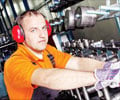EAR Shattering News! Latest research by Edwards and Schwartz Baum from the Institute of Environmental Medicine of the Karolinska Institute in Stockholm, Sweden, suggest,
EAR Shattering News! Latest research by Edwards and Schwartz Baum from the Institute of Environmental Medicine of the Karolinska Institute in Stockholm, Sweden, suggest, that people who are constantly exposed to loud noise, could risk developing a non-cancerous tumor, ultimately leading to deafness.
The Tumor, termed as Acoustic Neuroma, develops gradually with symptoms showing up only around the age of 50 or so. The Tumor exerts pressure on the cranial nerve, which supports the activities of sensation and balance. Perceived symptoms include constant and intrusive ringing in the ears, hearing loss or Tinnitus.The study included participants in the age group of 20 to 69, of which 146 participants already had the tumor and 564 people were without it. The group was interviewed with questions regarding their exposure to noise, frequency, type, and duration. Data regarding use of hearing protection was also collected.
The study revealed that, constant exposure to loud noise (noise from machines, power tools, construction, and music) increased the risk of developing the tumor almost 2.25 times. Exposure to noise from Airplanes, and Motor enhanced the risk of tumor by almost 1.3 times, while consistent exposure to the noise of screaming children increased the risk by 1.4 times. The duration of exposure to constant noise was a significant factor that contributed to the development of tumor. Five years of constant high decibel noise increased the propensity to develop the tumor.
According to the findings, wearing ear-protective aids, to a great extent, helped in reducing the development of tumor. It is possible to surgically remove the tumor, if it is diagnosed in the early development stage. Once the tumor is large, many complications may arise if the surgical option is sought. The tumor, most often is attached to facial nerves or nerves in charge of balance and hearing that may cause serious repercussions post surgery.
Unilateral Acoustic Neuroma, the commonest type of Acoustic Neuroma, affects only one ear. The tumor, though relatively rare, totally accounts to only 6-10% of skull-centric tumors. Bilateral Acoustic Neuroma is genetic and affects both the ears.
The study is available in the online edition of American Journal of Epidemiology and is due to be published in the printed edition of the Journal on February 15th.
Advertisement







